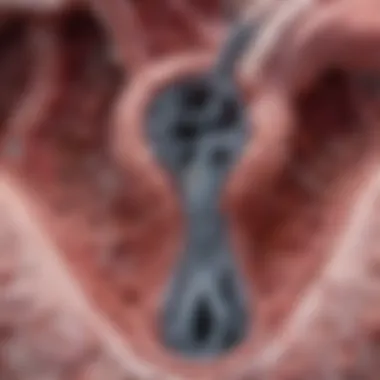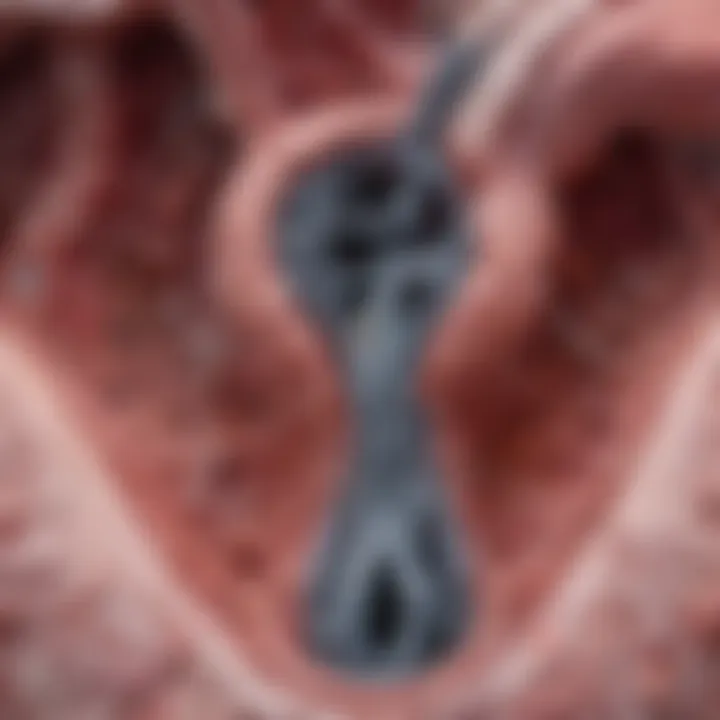Exploring the Link Between Bronchiectasis and COPD


Intro
Bronchiectasis and chronic obstructive pulmonary disease (COPD) are two significant respiratory conditions that can coexist and amplify each other’s effects on patient health. Understanding the relationship between these diseases is vital for effective management and treatment. Both conditions share overlapping symptoms, making accurate diagnosis challenging yet critical. This article explores the interplay between bronchiectasis and COPD, offering insights into their clinical complexities, pathophysiological mechanisms, and clinical management approaches.
Research Overview
Summary of Key Findings
Research shows that bronchiectasis often occurs in patients with COPD. The persistent inflammation and airway obstruction seen in COPD may contribute to the development and worsening of bronchiectasis. Additionally, individuals with both conditions experience a distinct set of symptoms and challenges that differ from those with either condition alone. The recognition of this interrelationship may lead to improved diagnostic and therapeutic strategies.
Background and Context
Bronchiectasis is characterized by the permanent dilation of the bronchi, leading to a buildup of mucus and frequent infections. COPD, on the other hand, is a progressive lung disease that includes emphysema and chronic bronchitis, primarily caused by smoking and environmental factors. Both conditions significantly impact the quality of life and require coordinated care. Understanding how these diseases impact one another can provide insights into patient management and treatment outcomes.
Methodology
Experimental Design
Studies investigating the connection between bronchiectasis and COPD often use a cross-sectional design. Patients are selected based on specific criteria, including a confirmed diagnosis of either or both conditions. Clinical evaluations and assessments are made to determine the extent of disease severity and associated symptoms.
Data Collection Techniques
Data is typically gathered through various means, including:
- Patient Surveys: To capture patient-reported outcomes, including symptoms and health-related quality of life.
- Pulmonary Function Tests: To evaluate lung function and airflow limitation.
- Imaging Studies: Such as chest CT scans to assess lung structure and the presence of bronchiectasis.
Researchers analyze these data sets to uncover patterns and correlations that illustrate the relationship between bronchiectasis and COPD.
Understanding Bronchiectasis
Understanding bronchiectasis is fundamental when exploring its relationship with chronic obstructive pulmonary disease (COPD). Accurately identifying and comprehending bronchiectasis can guide healthcare professionals in diagnosing and managing patients effectively. The distinct characteristics of bronchiectasis necessitate attention to its pathophysiology, clinical symptoms, and classification. Each of these elements contributes to a broader understanding of how bronchiectasis interacts with COPD. Recognizing this interplay is critical for optimal patient care.
Definition and Overview
Bronchiectasis is a chronic condition characterized by abnormal and permanent dilation of the bronchial tubes. This dilation results from repeated cycles of inflammation and infection, ultimately leading to irreversible lung damage. Patients with bronchiectasis often experience persistent cough, production of thick mucus, and recurrent lung infections. This condition can arise from various causes, including genetic disorders, previous lung infections, or autoimmune diseases. Notably, early diagnosis and intervention are essential for improving patient outcomes and quality of life.
Pathophysiology
The pathophysiology of bronchiectasis involves a complex interplay between various factors. Chronic inflammation damages the airway epithelium, leading to changes in mucus production and impaired mucociliary clearance. The accumulation of mucus creates a favorable environment for bacteria, resulting in recurrent infections. Over time, these infections lead to further airway destruction and fibrosis, exacerbating the disease. Understanding this progression is vital for physicians treating patients with both bronchiectasis and COPD, as similar mechanisms may drive the pathophysiology of both conditions.
Classification of Bronchiectasis
Bronchiectasis can be classified based on its underlying causes and radiological findings. There are two main types: cylindrical and varicose bronchiectasis.
- Cylindrical bronchiectasis presents as uniform dilation of the bronchi.
- Varicose bronchiectasis features a more irregular and distorted appearance.
Additionally, bronchiectasis may be classified as focal or diffuse. Focal bronchiectasis affects a specific area of the lungs, often due to localized infection or obstruction, while diffuse bronchiectasis involves widespread damage across the lung parenchyma.
Understanding these classifications not only aids in diagnosis but also informs treatment approaches, especially when considering how bronchiectasis may coexist with COPD.
Understanding Chronic Obstructive Pulmonary Disease (COPD)
Chronic Obstructive Pulmonary Disease, commonly known as COPD, is a term that signifies a group of progressive respiratory conditions. Understanding COPD is essential in the context of this article, particularly regarding its connection to bronchiectasis. Patients often present overlapping symptoms, which can complicate diagnosis and management. Recognizing the nuances of COPD helps in developing comprehensive treatment plans that also address bronchiectasis effectively.
Definition and Overview
COPD encompasses a range of diseases, including emphysema and chronic bronchitis. These conditions lead to long-term breathing difficulties, which can severely affect patients’ quality of life. The disease is primarily caused by long-term exposure to irritants, notably cigarette smoke, air pollution, and occupational dust. According to the Global Initiative for Chronic Obstructive Lung Disease (GOLD), COPD is characterized by persistent respiratory symptoms and airflow limitation.
The burden of COPD is substantial, affecting millions globally. It is estimated that over 250 million people suffer from COPD worldwide. Recognizing early signs and understanding the progression of this disease can lead to better management strategies.
Pathophysiology


The pathophysiology of COPD involves a complex interaction between inflammation and lung function irreversible changes. It begins with chronic inflammation of the airways, which leads to structural alterations in the lung parenchyma. The inflammation causes narrowing of airways, mucus hypersecretion, and destruction of the alveolar walls. This results in reduced airflow, making it difficult for patients to breathe. Lung function decline is gradual and can ultimately lead to respiratory failure.
Moreover, oxidative stress plays a critical role in COPD progression. Environmental toxins increase reactive oxygen species, which further exacerbates lung inflammation and damage. Understanding these mechanisms provides insights into potential therapeutic targets for managing COPD and associated diseases like bronchiectasis.
Stages of COPD
COPD is classified into different stages based on the severity of symptoms and airflow limitation. The GOLD classification system is widely used to determine these stages:
- Stage 1: Mild COPD
Patients may not experience significant airflow limitation. Symptoms such as cough and sputum production can appear but may be overlooked. - Stage 2: Moderate COPD
Noticeable shortness of breath begins during physical activities. This stage is often when individuals seek medical attention. - Stage 3: Severe COPD
At this stage, lung function significantly declines, leading to limitations in daily activities. Patients may experience increased breathlessness and frequent exacerbations. - Stage 4: Very Severe COPD
This is the end-stage of the disease, marked by severe airflow limitation and respiratory failure. Quality of life is greatly affected, and patients often require long-term oxygen therapy.
Understanding these stages of COPD is paramount for effective management and treatment, especially when considering coexisting conditions like bronchiectasis. Managing symptoms at each stage can significantly improve the patients' overall health and well-being.
Common Symptoms of Bronchiectasis and COPD
Understanding the common symptoms of bronchiectasis and chronic obstructive pulmonary disease (COPD) is crucial for effective diagnosis and management. These two diseases can present with overlapping symptoms, making it essential for healthcare professionals, including students, researchers, and educators, to recognize these manifestations. By identifying these symptoms early, clinicians can tailor treatment plans properly, potentially improving patient outcomes.
Respiratory Symptoms
Bronchiectasis and COPD share several respiratory symptoms that highlight the chronic nature of these conditions. One of the primary symptoms is chronic cough. Patients often experience a persistent cough that can produce various amounts of mucus. The quantity and appearance of the sputum can provide diagnostic clues. For instance, in bronchiectasis, the sputum may be purulent and foul-smelling due to infection. In contrast, patients with COPD might have more variable sputum character.
Another common respiratory symptom is shortness of breath, especially during physical activities. This symptom can start subtly but may progress over time as lung function decreases. Patients commonly describe it as a feeling of not getting enough air, which can be distressing and lead to decreased physical activity.
Wheezing and chest tightness can also be present in both conditions. These symptoms indicate the narrowing of the airways and can flare up with respiratory infections or environmental irritants. In addition, more advanced cases may result in chronic bronchitis, leading to increased respiratory distress.
Importantly, recognizing these respiratory symptoms early can lead to timely interventions, which may reduce the overall disease burden for affected individuals.
Systemic Symptoms
In addition to respiratory symptoms, bronchiectasis and COPD can also lead to systemic symptoms that affect overall health and quality of life. One prevalent systemic symptom is fatigue. Patients often report persistent tiredness, which may stem from chronic inflammation and the increased effort required for breathing. This fatigue can have a profound impact on daily activities and overall well-being.
Moreover, weight loss can occur in some individuals, particularly in advanced stages of these diseases. This is often attributed to increased energy expenditure due to labored breathing and potential loss of appetite resulting from chronic illness.
Patients may also experience recurrent infections, which can further exacerbate systemic symptoms. Frequent exacerbations can lead to cycles of treatment and recovery, causing additional stress and impacting social and occupational functioning.
Finally, anxiety and depression are common among patients with chronic respiratory conditions, influenced by the physical limitations and stigma associated with chronic illness. Addressing these systemic symptoms is a critical component of overall disease management, as mental health significantly affects physical health outcomes.
By understanding and addressing both respiratory and systemic symptoms, healthcare providers can more effectively support patients navigating the complexities of bronchiectasis and COPD.
Diagnosis of Bronchiectasis and COPD
The diagnosis of bronchiectasis and chronic obstructive pulmonary disease (COPD) is a critical aspect of managing these respiratory conditions. Proper diagnosis allows healthcare professionals to formulate an effective treatment plan and monitor disease progression. On the other hand, misdiagnosis can lead to inappropriate management, which may worsen patient outcomes. Thus, a comprehensive understanding of diagnostic methods is essential to differentiate these diseases and identify their overlaps.
Clinical Evaluation
Clinical evaluation serves as a foundational step in diagnosing both bronchiectasis and COPD. Medical history and a thorough physical examination are essential. In patients with bronchiectasis, symptoms often include chronic productive cough, sputum production, and recurrent respiratory infections. Conversely, COPD is characterized by a progressive shortness of breath and wheezing, especially with exertion.
During the evaluation, healthcare providers should inquire about the patient’s smoking history, exposure to pollutants, previous lung infections, and comorbid conditions that may influence lung health. The patient's age, living conditions, and occupational exposures should also be taken into account.
Routine examinations may include auscultation of lung sounds, which helps identify abnormal breath sounds indicative of airway obstruction or consolidation. These initial clinical assessments guide further diagnostic investigations.
Imaging Techniques
Imaging plays a significant role in the diagnosis of bronchiectasis and COPD. High-resolution computed tomography (HRCT) is the gold standard for bronchiectasis. It provides detailed images of the airways and can reveal characteristic features such as airway dilation and wall thickening. These findings are particularly important since they help distinguish bronchiectasis from other conditions that present similarly.
For COPD, chest X-rays may initially be used; however, HRCT imaging can also clarify the extent of emphysematous changes or bronchial alterations. Radiographic results support clinical findings and can aid in quantifying disease severity. Hence, imaging techniques are crucial for accurate diagnosis, assessment, and monitoring.
Pulmonary Function Tests
Pulmonary function tests (PFTs) are essential in diagnosing and managing both bronchiectasis and COPD. These tests provide objective measurements of lung mechanics and airflow limitations.
Standard PFTs include spirometry, which measures the volume of air exhaled and the rate of exhalation. In COPD, a marked reduction in the forced expiratory volume in one second (FEV1) compared to forced vital capacity (FVC) often indicates obstructive patterns. Bronchiectasis may show variable degrees of airflow obstruction, depending on its severity and the presence of coexisting conditions.
Another essential component is the assessment of gas exchange efficiency through diffusion capacity tests. These results can reveal underlying impairments not identifiable through spirometry alone.


Accurate interpretation of pulmonary function tests in the context of clinical findings will dictate the appropriate management strategies for each condition.
Diagnosis of bronchiectasis and COPD requires a multifaceted approach. Clinical evaluations, imaging technologies, and pulmonary function tests all contribute valuable insights. Understanding how these components interact enables healthcare professionals to provide tailored treatment plans for patients.
The Link Between Bronchiectasis and COPD
The interrelationship between bronchiectasis and chronic obstructive pulmonary disease (COPD) is significant for both clinical practice and research. Recognizing this link can lead to better management strategies for patients suffering from these chronic conditions. Understanding how bronchiectasis and COPD affect each other helps inform health care professionals about the complexity of treatment procedures and the necessity for personalized care plans.
In clinical environments, a proper grasp on this link allows for an integrated approach to patient management, emphasizing the importance of both diseases in patients. This section delves into the epidemiological evidence that connects the two disorders, outlines common risk factors shared by patients, and highlights the underlying mechanisms governing their interaction.
Epidemiological Evidence
Research indicates a substantial overlap between patients diagnosed with bronchiectasis and those with COPD. Studies have shown that individuals with COPD may exhibit structural changes in their bronchial airways, similar to those seen in bronchiectasis, which can exacerbate symptoms. For instance, a systematic review often mentions that up to 30% of COPD patients also show signs of bronchiectasis.
Additionally, the persistence of bacterial colonization in the lungs, particularly in patients with COPD, can lead to increased morbidity and mortality. The correlation figures heavily in epidemiological investigations, where a comprehensive understanding of these overlapping conditions might be necessary for urging preventive health measures and developing effective treatments.
Common Risk Factors
Both bronchiectasis and COPD share several risk factors that contribute to the development and progression of these diseases. Common risk factors include:
- Smoking: This is the most significant risk factor for COPD, which can also provoke bronchiectasis.
- Chronic Respiratory Infections: Frequent respiratory infections can result in airway damage, leading to both conditions.
- Environmental Exposure: Long-term exposure to pollutants, dust, or chemicals can deteriorate lung health, predisposing individuals to these diseases.
- Genetic Factors: Conditions such as alpha-1-antitrypsin deficiency may increase susceptibility to lung damage and subsequent disease development.
Awareness of these shared risk factors is crucial for healthcare providers. It guides them in preventative strategies and screening for at-risk populations.
Mechanisms of Interaction
The interaction between bronchiectasis and COPD occurs through various pathophysiological pathways. The airway obstruction seen in COPD can lead to impaired mucus clearance, a primary factor in bronchiectasis development. Mucus retention creates an environment where bacteria can thrive, leading to heightened inflammation, which exacerbates COPD symptoms.
Moreover, the persistent inflammation and infection characteristic of bronchiectasis can contribute to the progress of COPD. The result is a vicious cycle where each condition worsens the other, leading to significant declines in lung function and quality of life for patients.
It is essential for clinicians to recognize these interactions as they develop management plans tailored to individual patient needs.
By understanding the interconnected nature of bronchiectasis and COPD, healthcare professionals can implement more effective interventions that address the full spectrum of a patient's respiratory challenges. Ending this cycle requires an comprehensive, multifaceted approach.
Management Strategies for Patients with Both Conditions
In managing patients who have both bronchiectasis and chronic obstructive pulmonary disease (COPD), it is crucial to adopt comprehensive strategies. These strategies address the intertwined nature of the two conditions. Each condition can exacerbate the other, making it essential to develop a cohesive treatment plan. Better handling of both diseases can lead to improved quality of life and increased longevity for patients. This section delves into three primary strategies: pharmacological treatments, pulmonary rehabilitation, and patient education.
Pharmacological Treatments
Pharmacological intervention is a cornerstone of managing bronchiectasis and COPD. The goal is to minimize symptoms and prevent exacerbations. Commonly utilized medications include bronchodilators, corticosteroids, and antibiotics.
- Bronchodilators: These are vital for both conditions. They work by relaxing the muscles around the airways, which facilitates easier breathing. Patients can benefit from using short-acting bronchodilators on an as-needed basis, while long-acting ones may be used for more chronic management.
- Corticosteroids: In cases of significant inflammation, corticosteroids can help manage symptoms. They are often inhaled but can also be taken orally for severe flare-ups. Patient response should be monitored closely to avoid potential side effects.
- Antibiotics: Patients with bronchiectasis frequently experience respiratory infections. Therefore, proactive use of antibiotics can be effective in preventing bacterial colonization. Extended and tailored antibiotic therapy is often necessary due to the chronic nature of infections in these patients.
Tailoring these treatments according to individual needs ensures maximum benefit. Ongoing assessment is necessary to adjust the medication types and dosages.
Pulmonary Rehabilitation
Pulmonary rehabilitation is another vital strategy that combines exercise training, education, and behavioral interventions. This structured program can significantly enhance functional status and quality of life for patients with both bronchiectasis and COPD.
- Exercise Training: Incorporating aerobic and strength-building exercises helps improve overall lung function. Patients can often experience an increase in their exercise capacity, which contributes to daily activities and psychosocial well-being.
- Education: Education about the diseases is critical for self-management. Patients learn about their conditions and recognize signs of exacerbation or infection early. Knowledge empowers patients to take a proactive approach, resulting in better adherence to treatment plans.
- Behavioral Interventions: Mental health plays a role in chronic illness management. Cognitive behavioral therapy and other support interventions can help patients cope with anxiety and depression, which are common in chronic diseases.
Patient Education
An educated patient is a more effective participant in their healthcare journey. Patient education encompasses understanding the diseases, treatment methods, and lifestyle modifications.
- Understanding the Conditions: It is essential for patients to grasp the nuances of bronchiectasis and COPD. Knowledge about how these diseases affect respiratory health enables them to advocate for themselves better.
- Importance of Treatment Adherence: Education about why adherence to treatment is crucial can lead to more consistent medication use. Patients are often more compliant when they comprehend the risks of non-adherence.
- Lifestyle Modifications: Patients should be informed on the impacts of smoking cessation, nutrition, and exercise on their conditions. Guidance in these areas can reduce symptom severity and improve overall health outcomes.
"Effective management of bronchiectasis and COPD requires a multi-faceted approach, ensuring that patients are not only treated but also empowered to understand their conditions."
Challenges in Treatment and Management


The management of bronchiectasis and chronic obstructive pulmonary disease (COPD) introduces a variety of challenges for healthcare providers. Understanding these challenges is essential for optimizing treatment outcomes, as both conditions share similar symptoms and pathophysiological mechanisms. Patients often present with overlapping features, which complicates proper diagnosis and intervention. Additionally, adherence to treatment regimens and the presence of coexisting conditions can significantly impact management strategies. This section delves into these critical issues, emphasizing the need for a comprehensive approach to treat individuals who suffer from both diseases.
Adherence to Treatment
Adherence to treatment is one of the most significant hurdles in managing bronchiectasis and COPD. Many patients struggle to follow prescribed therapies, which can lead to disease progression and frequent exacerbations. Non-adherence may stem from several factors, including complex medication regimens, side effects of medications, and a lack of understanding of the severity of their conditions.
To counteract these issues, healthcare providers must emphasize patient education regarding the importance of adherence. Clear communication about treatment benefits and the risks of non-adherence can assist patients in recognizing the value of sticking to their regimens. Additionally, using simplified medication plans and developing personalized treatment strategies can enhance adherence rates. Incorporating support systems, such as regular follow-up appointments and using digital health tools, can also foster a sense of accountability and encourage patients to remain diligent.
Coexisting Conditions
Coexisting conditions present considerable complexities in the treatment of bronchiectasis and COPD. Many patients with these respiratory disorders often have comorbidities, such as asthma, heart disease, or diabetes. These additional health issues can complicate management strategies, as clinicians must consider the potential interactions between medications and the varying impact of treatments on multiple conditions.
For instance, the use of corticosteroids in COPD exacerbations may exacerbate underlying infections or coexisting respiratory issues in bronchiectasis patients. Furthermore, managing these comorbidities effectively requires a multidisciplinary approach, involving various specialists to align treatment objectives and avoid potential conflicts in care.
An integrated care model can significantly benefit patients, as it ensures all health aspects are managed in harmony with one another. This approach not only improves overall health outcomes but also strengthens the patient-provider relationship by fostering a collaborative atmosphere in managing complex conglomerations of health issues.
Understanding the interplay between treatments for bronchiectasis and COPD alongside any coexisting conditions is pivotal for effective management. Proper coordination and communication among health professionals can help navigate these challenges.
By addressing adherence and the influence of coexisting conditions, we can begin to develop comprehensive strategies that optimize health outcomes for individuals who face the dual challenge of bronchiectasis and COPD.
Future Directions for Research
Research in the field of bronchiectasis and chronic obstructive pulmonary disease (COPD) is crucial. Understanding these conditions in greater depth can lead to better patient outcomes. Future research directions focus on innovative treatments and personalized medicine, which show promise for patients suffering from both diseases.
Innovative Therapeutic Approaches
Recent developments in therapies are gaining attention. Innovative approaches include the application of biologic agents. They are designed to target specific inflammatory processes in the airways. For example, monoclonal antibodies may reduce exacerbations in selected patients. Other therapies involve designing medications that address mucus production and airway clearance.
Inhaled therapies continue to evolve, with formulations tailored for individuals. The use of combination therapies that include bronchodilators and corticosteroids may provide broader symptom control. Additionally, early trials on gene therapy are underway, offering hope for long-lasting effects by correcting underlying genetic defects.
Patients could benefit from these treatments, particularly those who frequently experience exacerbations. New drug classes may also help in managing cough and sputum production, which are significant issues for many patients with these respiratory diseases.
Genetic Studies and Personalized Medicine
Personalized medicine represents a shift in how care is provided for bronchiectasis and COPD patients. Genetic studies are increasingly identifying biomarkers associated with disease progression and treatment response. Understanding these genetic factors can help tailor therapies to individual needs, allowing for more targeted interventions.
Identifying specific genetic markers can guide clinicians in predicting disease outcomes. For instance, patients with different genetic profiles may respond differently to standard therapies. By aligning treatment with individual genetic and phenotypic characteristics, there is a potential for improved management of both conditions.
Moreover, ongoing research aims to uncover the genetic basis of co-morbid conditions often associated with bronchiectasis and COPD. This could lead to the development of treatments designed for those with multifaceted health issues. Genomic sequencing technologies are becoming more accessible, which may accelerate this area of research.
The confluence of innovative therapies and personalized medicine could shift the paradigm in managing bronchiectasis and COPD, offering both hope and practical solutions for those affected by these chronic diseases.
The End and Implications for Practice
The interrelationship between bronchiectasis and Chronic Obstructive Pulmonary Disease (COPD) is an area of increasing relevance in clinical practice. Understanding the complexity of these two respiratory conditions is crucial for effective management and improving patient outcomes. Acknowledging that these diseases often coexist allows clinicians to adopt a more nuanced approach to treatment, recognizing the multifaceted nature of respiratory pathology.
The findings from this article highlight several key implications for practice. First, clinicians must be aware of the overlapping clinical features and diagnostic challenges posed by bronchiectasis and COPD. This knowledge fosters an environment where a comprehensive assessment can lead to better treatment regimens tailored to each patient’s specific needs.
Moreover, the implications extend beyond diagnosis. Effective attention to management strategies can significantly alleviate symptoms and enhance quality of life. Evidence suggests that integrated care approaches, which address both conditions simultaneously, tend to yield favorable results. This means that healthcare providers should consider collaborative care models that involve pulmonologists, respiratory therapists, and primary care providers to formulate comprehensive treatment plans.
"The interplay between bronchiectasis and COPD calls for an evolved understanding of pulmonary health, bridging diverse specialties toward patient-centered care."
Lastly, this exploration emphasizes the need for ongoing education and research regarding these diseases. As the medical landscape continues to evolve, informed clinical practices based on solid research findings will empower healthcare professionals to deliver more effective interventions. Clinicians should thus stay updated with the latest studies and guidelines to ensure the best practices reflect current understanding.
Summary of Findings
This article has explored the connections between bronchiectasis and COPD, revealing crucial findings that underscore their relationship. Both conditions share overlapping symptoms, diagnostic criteria, and pathophysiological mechanisms. This interplay complicates both diagnosis and management. Some of the main points include:
- Common Symptoms: Patients often report similar respiratory symptoms, like chronic cough and sputum production.
- Shared Risk Factors: Smoking and environmental factors impact both conditions, suggesting a need for targeted preventive measures.
- Diagnostic Methods: Comprehensive evaluation using imaging and pulmonary function tests can facilitate accurate diagnosis.
- Integrated Management Approaches: Addressing both conditions concurrently through pharmacological and rehabilitative strategies can enhance patient care.
In summary, the interconnected nature of bronchiectasis and COPD necessitates that clinicians consider both diseases during evaluation and treatment processes.
Recommendations for Clinicians
Based on the insights gathered, several strategic recommendations emerge for clinicians managing patients with bronchiectasis and COPD:
- Advocacy for Early Diagnosis: Clinicians should prioritize the early detection of either condition in patients with respiratory symptoms. Late diagnosis can significantly hinder effective management.
- Comprehensive Assessments: Employ a multifaceted approach in patient evaluations, integrating clinical history, physical examinations, and appropriate diagnostic imaging to rule out or confirm both conditions.
- Individualized Treatment Plans: Tailor treatment options based on patient comorbidities, severity of symptoms, and individual preferences. Medications, such as bronchodilators or anti-inflammatory drugs, should be prescribed judiciously.
- Incorporating Pulmonary Rehabilitation: Encourage participation in rehabilitation programs focused on improving lung function and overall endurance, which benefits both bronchiectasis and COPD patients.
- Patient Education: Educate patients about their conditions, emphasizing the importance of adherence to treatments and recognizing early symptoms of exacerbation.
- Monitor Progression: Regular follow-ups should be scheduled to track the progression of both diseases, adjusting treatment strategies as necessary to optimize management.
By implementing these recommendations, clinicians can enhance patient outcomes and quality of life for individuals affected by bronchiectasis and COPD.







